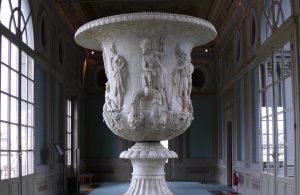Uffizi Unveils Restored Medici Vase
 In ancient times, the Greek vase form known as a krater was used to serve wine at celebrations; the Uffizi has just unveiled “a sculptural superstar,” as director Eike Schmidt calls it, the newly restored Medici Vase. This krater dates from 30 B.C, and once decorated the garden of a wealthy family living in the center of Imperial Rome.
In ancient times, the Greek vase form known as a krater was used to serve wine at celebrations; the Uffizi has just unveiled “a sculptural superstar,” as director Eike Schmidt calls it, the newly restored Medici Vase. This krater dates from 30 B.C, and once decorated the garden of a wealthy family living in the center of Imperial Rome.
THE MEDICI VASE
The huge vase (5 ft. 8 inches or 1.72m without its marble base) is a very rare example of one of the largest surviving – and most beautiful – works commissioned to Athenian artists by Roman patricians. The nonprofit organization Friends of Florence headed by Simonetta Brandolini d’Adda financed its painstaking restoration.
Mentioned in the 1598 inventory of Villa Medici, in 1780 Pietro Leopoldo, Grand Duke of Tuscany, brought the vase to the Uffizi, where the public has been able to admire it ever since, except from 1800 to 1803, when it was hidden from Napoleon and his troops in Palermo. Napoleon procured instead the ancient Borghese Vase, another first century B.C. krater, now on display at the Louvre.
In the newly refurbished Arno Loggia, today’s visitors to the Uffizi can once again marvel, as they did in earlier eras, at the delicate marble carving of the vine and acanthus leaves and the polished details of the figures, whose complete identity remains a mystery. “It was supposed to not be understood” says Uffizi Curator of Sculpture Fabrizio Paolucci, “the patron was part of an elite circle in Augustan Rome, and thus the subject matter was intended to remain esoteric to outsiders.” This is the only sculpture of its kind in existence today depicting historical as well as mythological characters.
The figures carved on the frieze most likely represent Athenians gathered to consult the Oracle of Delphi before leaving to fight in the Trojan War. A half-naked woman adorned with drapery, probably Iphigenia, sits pensively below the statue of Artemis, goddess of the hunt. On either side of the base carved with acanthus leaves, two fluted loop handles rise from large, expressive satyrs’ heads.
During the restoration project led by conservator Daniela Manna, the vase was carefully cleaned using demineralized water, and only those prior restoration treatments, which had discolored, were carefully removed with mild solvents. Extensive diagnostic testing by Susanna Bracci of C.N.R. and non-invasive microscopic analysis by Andrea Rossi revealed that, while the vase was excavated in a damaged state, over 90% is composed of 1st century Greek marble. Researchers were astonished to find many traces of the original painted layer, including yellow ocher, cinnabar, blue, green and gold leaf. (elizabeth wicks)
